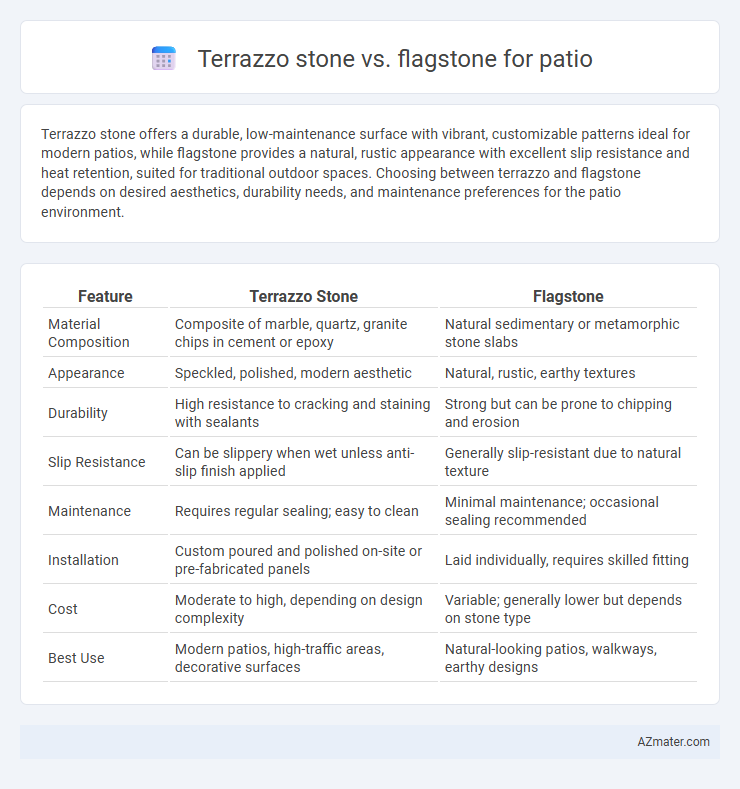Terrazzo stone offers a durable, low-maintenance surface with vibrant, customizable patterns ideal for modern patios, while flagstone provides a natural, rustic appearance with excellent slip resistance and heat retention, suited for traditional outdoor spaces. Choosing between terrazzo and flagstone depends on desired aesthetics, durability needs, and maintenance preferences for the patio environment.
Table of Comparison
| Feature | Terrazzo Stone | Flagstone |
|---|---|---|
| Material Composition | Composite of marble, quartz, granite chips in cement or epoxy | Natural sedimentary or metamorphic stone slabs |
| Appearance | Speckled, polished, modern aesthetic | Natural, rustic, earthy textures |
| Durability | High resistance to cracking and staining with sealants | Strong but can be prone to chipping and erosion |
| Slip Resistance | Can be slippery when wet unless anti-slip finish applied | Generally slip-resistant due to natural texture |
| Maintenance | Requires regular sealing; easy to clean | Minimal maintenance; occasional sealing recommended |
| Installation | Custom poured and polished on-site or pre-fabricated panels | Laid individually, requires skilled fitting |
| Cost | Moderate to high, depending on design complexity | Variable; generally lower but depends on stone type |
| Best Use | Modern patios, high-traffic areas, decorative surfaces | Natural-looking patios, walkways, earthy designs |
Introduction to Patio Flooring Options
Terrazzo stone offers a sleek, modern aesthetic with durability and low maintenance, ideal for high-traffic patios seeking a polished finish. Flagstone provides a natural, rustic appeal with textured surfaces that enhance outdoor spaces with warmth and slip resistance. Comparing terrazzo's dense composite material to flagstone's sedimentary layers helps homeowners choose based on style preference and functional needs for their patio flooring.
What is Terrazzo Stone?
Terrazzo stone is a composite material made from chips of marble, quartz, granite, or glass embedded in a cement or resin binder, polished to a smooth, durable finish ideal for patios. It offers a sleek, modern aesthetic with customizable color patterns, making it resistant to stains and weathering. Unlike flagstone, which is a natural, irregularly shaped sedimentary rock, terrazzo provides a uniform surface and greater design versatility for outdoor spaces.
What is Flagstone?
Flagstone is a flat, sedimentary rock commonly used for patios, walkways, and outdoor flooring due to its natural, rustic appearance and durability. Composed mainly of sandstone, limestone, or slate, flagstone offers varied textures and colors that blend seamlessly with outdoor environments. Its slip-resistant surface and ease of installation make flagstone a popular choice for creating visually appealing and functional patio spaces.
Visual Appeal: Terrazzo Stone vs Flagstone
Terrazzo stone offers a sleek, polished surface with vibrant color variations achieved through embedded chips of marble, quartz, or glass, providing a modern and sophisticated aesthetic for patios. Flagstone features a natural, earthy texture with irregular shapes and warm tones that create a rustic and organic appearance, blending seamlessly with outdoor landscapes. The choice between terrazzo stone and flagstone hinges on the desired visual appeal: terrazzo delivers a smooth, contemporary look, while flagstone emphasizes natural beauty and rugged charm.
Durability and Longevity Comparison
Terrazzo stone exhibits superior durability with its composite mix of marble, quartz, and glass chips embedded in cement, providing high resistance to cracking and weathering ideal for patios in extreme climates. Flagstone, composed primarily of sedimentary rock, offers natural slip resistance and moderate durability but is more susceptible to chipping and erosion over time, especially in freeze-thaw conditions. The longevity of terrazzo patios typically surpasses flagstone installations, lasting several decades with proper sealing and maintenance, while flagstone may require more frequent repairs or replacement to maintain structural integrity.
Maintenance Requirements
Terrazzo stone patios demand regular sealing and gentle cleaning with non-abrasive products to maintain their glossy finish and prevent staining. Flagstone requires periodic sealing to guard against moisture penetration but generally tolerates more rugged cleaning methods without damage. Both materials benefit from prompt removal of dirt and debris to extend their durability and aesthetic appeal in outdoor settings.
Slip Resistance and Safety Features
Terrazzo stone offers a smooth, polished surface that can become slippery when wet, requiring the application of slip-resistant coatings to enhance safety on patios. Flagstone naturally provides a textured, rough surface with inherent slip resistance, making it a safer choice for outdoor areas exposed to moisture. Both materials benefit from proper sealing and maintenance to maximize their slip resistance and ensure a secure, safe patio environment.
Cost Analysis: Terrazzo vs Flagstone
Terrazzo stone typically costs between $50 and $100 per square foot, factoring in its installation complexity and customization options, while flagstone averages $15 to $30 per square foot, making it a more budget-friendly choice for patios. Maintenance expenses also vary, as terrazzo requires regular sealing to preserve its polished finish, potentially increasing long-term costs compared to flagstone's easier upkeep. The initial investment for terrazzo is higher due to its durable material and aesthetic appeal, but flagstone offers cost-effective versatility with natural stone textures suited for various landscaping projects.
Installation Process Differences
Terrazzo stone requires a meticulous installation process involving a concrete or cement base with embedded marble, quartz, or glass chips, followed by grinding and polishing to achieve a smooth, glossy finish. Flagstone installation is simpler, typically laid directly onto a compacted base of sand or gravel with mortar or mortarless methods, emphasizing natural, irregular shapes and gaps filled with sand or mortar. Terrazzo demands a professional with specialized equipment for polishing, while flagstone can be installed by experienced DIYers or professionals using conventional masonry tools.
Which is Best for Your Patio?
Terrazzo stone offers a sleek, polished finish with enhanced durability and resistance to stains, making it ideal for modern patios requiring low maintenance. Flagstone provides a natural, rustic appearance with excellent slip resistance and good weather tolerance, perfect for outdoor spaces emphasizing a traditional or organic aesthetic. Choosing between Terrazzo and Flagstone depends on your patio's desired style, climate conditions, and maintenance preferences.

Infographic: Terrazzo stone vs Flagstone for Patio
 azmater.com
azmater.com